When is the best time of year for your interior & exterior painting?
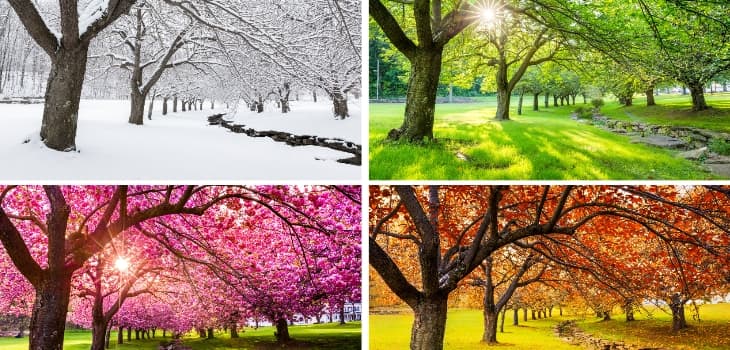
Variations in the weather can impact the quality of a paint job, particularly the exterior surfaces. Hot summers and cold winters, dry days and wet days, high humidity and low humidity – they all have an impact on painting projects. At Painters Inc., we know the best and worst time to take on a painting job, but we also have the tools and knowledge to get the best results, regardless of the season.
The best time of year for interior and exterior painting can also depend on your environment. For example, if you have many trees close to your structure, bringing in a painting crew during the spring before the leaves have filled out the trees would be a better option than the summer, when the foliage gets in the way and is a hindrance for the painters.
The best time of the year for interior painting can also depend on a number of factors, including the type of paint that is being used. Some specialty paints are oil or solvent-based, which means they will give off a lot of fumes, so you wouldn’t want to apply them during a time of year when you can’t open your windows (super hot summer days or bitter cold winter days and nights). When you talk to your painting contractor about all the variables, you can nail down the perfect time of year to do either exterior or interior work.
Check out the following to figure out which is best for you:
- How temperature and humidity affect paint and painting application
- The Chicago area’s ideal weather conditions for painting
- What's the best season to paint commercial properties in the Chicago area?
- Painting in the winter season
- Painting in the summer season
- Painting in the fall season
- Painting in the springtime
- Best time for interior painting in the Chicago area
- Best time for exterior painting in the Chicago area
- Why spring is the best time to get your HOA or condo professionally painted
- FAQs
How temperature and humidity affect paint and painting application
When moisture is in the air (humidity), there is moisture on your surfaces, leading to a slow paint drying process. Temperature also impacts how paint dries. Quality painting contractors know how temperature and humidity impact quality and they know how to avoid adverse situations.
The effect of ambient temperature
Paint thickens in low ambient temperatures, which means if it’s cold enough, the paint never really dries and you run the risk of having your paint sag or see long runs and/or creases. Paint is also more difficult to apply in the cold. Most paint manufacturers recommend painting in temperatures between 50 and 90 degrees, but top quality brands, like Benjamin Moore and Sherwin-Willams have developed formulas for some of their paint that allow painters to do their work in temps as low as 35 degrees.
When temperatures are too hot, the paint dries too fast, which leads to bumps and wrinkles. When it dries too fast the binding properties in the paint never get an opportunity to do what they are designed to do, thus the wrinkles and bubbles or blisters. This is especially true when the surfaces are in direct sunlight on hot days.
The effect of relative humidity
Relative humidity plays a role in how paint adheres to surfaces. For example, when the humidity is high, surface areas are exposed to water vapor, and when paint is applied on top of that moisture, you’ll get bubbling and/or peeling paint as a result.
The preferred humidity is between 40 and 70 percent, because this is within the range that paint can properly adhere to surfaces.
The effect of wind
If you see a cracking or blistering paint on a surface, it’s not always because of heat, humidity or age – it could be a result of paint applied on a windy day. Paint needs time to cure, but if you’re painting in the wind, instead of getting a slow and steady dry/cure over a 24-hour period, the paint dries too fast and doesn’t properly adhere to the surface.
At Painters Inc., we know that painting in winds exceeding a gentle breeze, around 8 mph, is a bad idea and will only produce problems down the line.
The Chicago area’s ideal weather conditions for painting
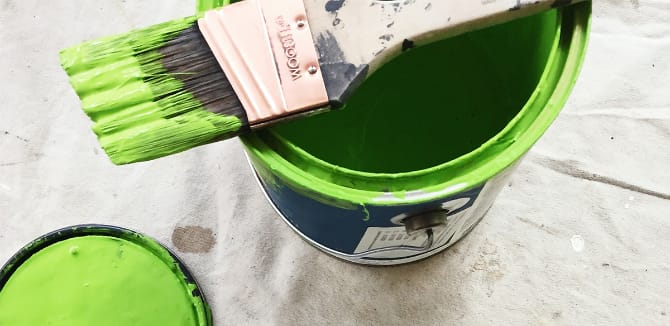
Interior painting projects are usually not a problem because most interiors are climate controlled. However, heating and cooling systems have an impact on humidity, which needs to be monitored.
Exterior painting projects in Chicago are at the mercy of Midwestern weather extremes. Average winter temps from December through February are around 28 degrees – too cold for exterior painting projects. Average temps in the spring become more amenable to painting, rising from 37 degrees in March to an average of 59 degrees in May.
At Painters Inc., the bulk of our exterior painting projects are taken on during the summer months, but are put on hold when Chicago gets the blast furnace experience during brutal heat waves. Temperatures begin to drop in September and October, but are still in an acceptable range for painting.
The following are the ideal conditions for exterior painting:
- 40% to 70% relative humidity
- less than 8mph wind
- temperature between 50 to 85 degrees (exceptions made for some paint types)
- zero rain risk during the paint application process and the following 24 hours as paint cures
What's the best season to paint commercial properties in the Chicago area?
At Painters Inc., we are active from the spring through the fall and will take exterior work in the winter if the temperature allows. Like most painting contractors, we’re busiest during the summer when conditions are the most consistently ideal for applying paint to exterior surfaces. Our focus is on quality outcomes – we want the paint to look superb and last for a long, long time. In order for that to happen, we have to keep a close eye on heat, humidity, wind and rain, so we don’t schedule projects when the conditions are less than ideal.
Building painting in the winter season
Chicago is often too cold and windy during the winter to take on exterior painting projects. Chicago has an average of 43 days a year where the temps get below freezing and paint can’t adhere properly in those conditions. However, it’s a perfect time for climate-controlled interiors to be painted. The following are some of the advantages to scheduling your painting project during the winter months.
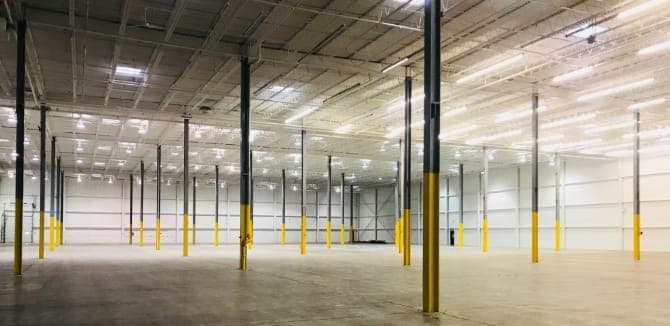
Benefits of hiring painting contractors during the winter
Everyone is hunkered down indoors during the winter as the temperatures plunge and the days shorten. This is the time when people notice their interiors require repainting, but is the winter a good time for these projects? The answers is “yes,” and here’s why:
- More availability
With the summer being crammed with exterior painting projects, there isn’t much availability for interior jobs. But when the winter hits, painting contractors are eager to get those interior paint jobs to keep their crew working until the next busy season. - More affordable
Most contractors can attest to the fact that winter months slow down in regard to painting projects, so to entice more customers they lower their prices slightly. You can probably even arrange this project well in advance and still have a discount to look forward to, as contractors appreciate having work scheduled. - No need to open all the windows, just use the right paint
Rather than suffer through the paint fumes associated with a closed-window property during the cold Chicago winters, choose a contractor that uses the right paint. At Painters Inc., we use high-quality paint from Benjamin Moore and Sherwin-Williams that are low to zero-VOC, which means your property will not be filled with fumes. - Less disruptive to the customers or staff
Some businesses experience a reduction in customers and staff in their facilities during the winter, which means a painting project will be less disruptive. When the foot traffic is low, there are fewer obstructions, which means the painters can complete their tasks at a more rapid rate. Furthermore, some businesses close around the holidays, leaving a clear and open property to paint. - More availability for smaller projects
Have you been itching to tackle some smaller projects, like touch-up jobs, repainting trim or bring in some new accents to liven up the interiors? The winter is a perfect season for quick jobs like these.
From having your ceilings painted or checking into possible code violations related to paint, there are a wide variety of projects that can be undertaken during the winter months, including floor treatment, painting warehouses and offices and just about anything in between. At Painters Inc., the winter months are a perfect time to schedule an interior project with us because you’ll save time and money and avoid all the usual hassles of interior work.
Commercial building interior painting in the winter
When the winter weather prohibits outdoor painting projects, commercial building owners/managers tackle their indoor painting needs, from touch ups to completely new colors and designs. Winter is a great time to take stock of the current paint situation on indoor surfaces and choose which areas could use a new coat.
There is a misconception that the humidity is lower in the winter than in the summer, but in Chicago, the average winter humidity level is roughly four percent higher. This has to be taken into account, because humidity affects how paint adheres to surfaces. You also have to take into account the temperature of the walls, but since most commercial properties are climate controlled, this doesn’t present much of a challenge with interior painting.
Using infrared thermometers, quality painting contractors will ensure that the surfaces they paint during the winter aren’t below 35 degrees, which is the lowest that a select few specialty paints can be applied and still dry correctly (no wrinkles, bubbles or cracking). Quality contractors will also choose the right types of paint that can handle being applied in cooler weather. This ensures proper spread during application and lifespan. Furthermore, choosing the right type of paint will boost the aesthetic appeal.
Don’t wait until spring or summer to schedule your interior commercial painting project – take full advantage of contractors’ availability during the slower winter months. At Painters Inc., our crew is ready to tackle your indoor project. We use zero- to low-VOC paints, which means you don’t have to open the windows and air out the fumes. Contact us and let’s discuss the scope of the work.
Commercial building exterior painting in the winter
Planning is the key to success in an exterior painting project on a commercial building during the winter. The majority of paints can’t be applied to surfaces below 35 degree, which means projects have to be planned around the forecast. Most contractors will shoot for 50 degree days, as the outcomes are more desirable.
When a bitter cold snap eases into Chicago, exterior painting projects must be put on hold, as the paint will not dry correctly in these temperatures.
There are exceptions to the 35 degree rule. For example, Sherwin-Williams makes a solvent-based paint that can be applied to concrete at temperatures as low as 20 degrees, but it takes longer to apply and longer to dry. Water-based paints, however, shouldn’t be applied when the temperature drops below 35, because while the paint might look fine at first, the long-lasting positive effects you expect out of a quality paint won’t present themselves. Rather, your paint is more likely to crack or chip far sooner than normally expected.
At Painters Inc., our experience is that when the humidity is not too high and the temperature stays above 35 (even overnight temperatures), our winter exterior painting projects have great success. If we do have overnight lows below 35, we make sure to begin painting as early as possible, giving the paint time to dry before it gets too cold. We’re also careful to choose the right types of paints, which are specially formulated to hold up in colder temperatures.
Another reason to consider taking on an exterior painting project in the winter is that you might get a deal. Summers are notoriously busy for painting contractors, but things slow down during the winter, so you not only have more availability, you might also get a contractor at a reduced rate compared to what you would pay for the same work in the summer.
What paints are the best for cold weather?
Water-based paint on cold surfaces is not ideal. You face extended drying times, peeling, and when painting with latex, it won’t form a film, which compromises its ability to last. Fortunately, cold weather painting projects can happen due to the specially formulated paints that quality manufacturers, such as Sherwin-Williams and Benjamin Moore produce.
At Painters Inc., we’ve used Benjamin Moore’s MoorLife, Super Spec and MoorGuard paints when the weather gets no colder than 40 degrees and have had exceptional outcomes. We’ve also used Sherwin-Williams’ Resilience, which has the trademarked MoistureGuard built in, allowing it to resist higher winter humidity. For projects that will involve temps as low as 35 degrees, we’ve used Emerald, Duration, A-100 and SuperPaint from Sherwin-Williams.
Building painting in the summer season
While the most optimal environment for painting is during the summer months, contractors avoid painting in direct sunlight. When paint dries too fast, it doesn’t have time to cure. That’s why they avoid painting in direct sunlight during the summer.
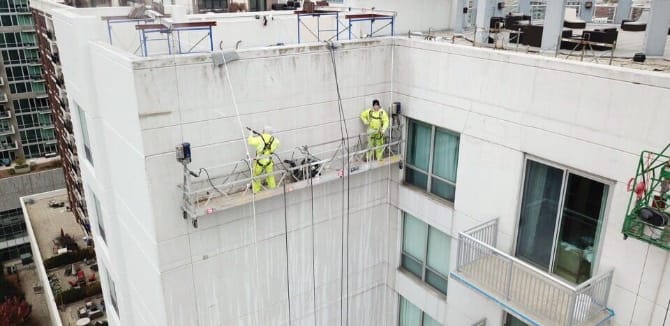
Chicago summers can get quite heated, so it’s always wise to keep an eye on the temperature and never schedule a painting project when the temperature gets over 100 degrees. When it gets this hot, the surfaces will not have a chance to absorb the paint, which means it won’t adhere properly and will peel, blister or crack.
Benefits of hiring painting contractors during the summer
You want your painting job to last as long as possible. In order for that to happen, you have to choose the contractor that uses the right paint and applies it under the right conditions. There are far more good weather days during the summer than any other time of year in Chicago, which makes summer the most desirable time of year to hire a painting contractor.
The following are some of the top reasons to take on a painting project in the summer:
- Faster job completion
The longest summer day has 15 hours of sunlight. With more daylight, painters can work longer hours, which leads to faster completion. If you need a job done quickly, one that isn’t drawn out for weeks because of unfavorable conditions, summer is the optimal time. - Quicker paint drying process
The faster paint dries, the faster another coat can be applied. Summer offers optimal conditions for paint to dry at the right speed – not too fast and not too slow. This means that painters can apply multiple coats in the day and knock out projects faster. It’s important to note that when the temps creep up to 100, the paint will dry too fast, so avoid painting in extreme heat. - Brighter sunlight
Light and how it plays in your interiors is important when choosing the right colors. When the sunlight is brighter during the summer, you get a truer representation of what the color will actually be. Winter light can make the selection process a little trickier. For example, too many shadows in a room could lead to choosing a color that is too bright for the longer summer days. - Thinner paint
Warmer temperatures make paint easier to prepare and apply, because heat allows it to thin out. Painters will be able to apply it faster, leading to less labor costs and faster completion times. - Paint smells diffuse quickly
While the zero- to low-VOC paints commonly used today have less odor than their higher VOC predecessors, there is still a hint of odor to them. With the summer air being warm and dry, the odor of the paint will dissipate faster than other times of the year.
When you work with a quality painting contractor during the summer, they will be aware of all the conditions that can help or distract from a painting job. They will plan around the forecast and make sure your paints will adhere correctly and last a long time. That’s what we offer at Painters Inc.
Commercial building interior painting in the summer
Despite the fact that the days are longer during the summer, which means your painting contractor can put in longer hours under natural light, interior painting during the summer means you can open your windows and allow the paint aroma to dissipate faster. This is particularly useful if the surfaces you are painting must be covered in higher VOC paints, which leave fumes that need to be aired out.
If your surfaces require more than one coat, the paint will need time to dry between each application.
In warmer weather, the drying time is significantly reduced, which means multiple coats can be applied in the same day.
This will reduce the project time and get your interiors looking great in no time at all. Of course, avoid painting when the temperatures reach 100 degrees, as this can lead to the paint drying too fast and will negatively impact its lifespan.
Summertime offers hours and hours of natural light, which painters use to their benefit, especially when it comes to choosing paint colors. When the natural light comes through the windows, you get a much different effect than with artificial light; you get a truer sense of what the colors you’re considering will look like on your surfaces under natural light.
Warmer temperatures will thin the paint, which is a benefit to painters as application is easier. Thinner paint is easier to mix, so the colors are perfectly incorporated into the other paint materials. Rather than using thinner, as some painters do during the winter months, painters get the right viscosity in warm weather, leading to a high-quality application, which translates into a better look and a longer lasting result.
Commercial building exterior painting in the summer
Summer is the most popular season for commercial building owners/managers to hire contractors for exterior painting projects. Not only are the days long, giving painting crews plenty of hours of daylight, but the weather is the most favorable. The only consideration is that the painters avoid applying paint in direct sunlight, in rain or during super hot days when the temperature nears 100 degrees.
Paint dries relatively fast in the warm summer air, which means jobs that require multiple coats can be applied in the same day. Some exterior paints have more materials in their recipe, which means they can be thicker. In the warm air, exterior paint like this will thin out just enough so that the viscosity is perfect, making it easy to apply.
Painters can get the paint on faster, reducing the labor hours and making the project more affordable.
Professional painters know to avoid painting on days when the temperature gets too hot. They carry special thermometers that measure the surface temperature, so they know if a surface is too hot, they will not paint it. Hot surfaces make the paint dry really fast, which means it doesn’t have a chance to absorb into the surface and properly adhere. This will later lead to peeling, cracking and/or blistering.
At Painters Inc., we plan our commercial exterior painting projects carefully. We know to avoid wet weather painting or painting on days when the temperature spikes to 100. We’re focused on quality outcomes in every exterior job we do, which is why we use the right tools for these types of jobs and hire quality painters with years of experience on exterior projects.
What interior and exterior paints are the best for hot weather?
While the summer offers some of the best painting days of the year, extreme temperatures have an adverse effect on paint. You don’t want your paint to bake, as this will cause it to dry too fast and not adhere to your surfaces correctly.
Professional painters know which paints work best in warmer temperatures and for areas that are subjected to the sun’s ultraviolet (UV) rays. For example, paints made with UV-resistant formulas are popular for exterior surfaces. When painting interiors with latex paint during the summer, make sure you’re not painting in temperatures over 85 degrees.
Building painting in the fall season
While fall seasons can be rainy, there are some optimal days for building painting. November in Chicago sees average highs of 50 degrees, which is a prime temperature for painting because the chemicals in the paint react perfectly: dry times aren’t too fast or too slow. The paint dries very evenly in this type of environment. Also, painting in the fall allows you to open windows to let the paint aroma out without having to worry about letting in hot or cold air that can negatively impact the quality of the paint.
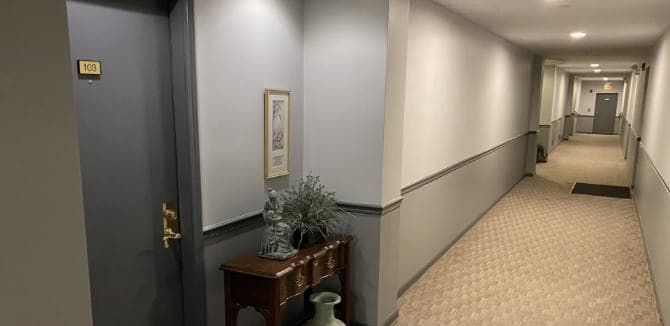
Commercial building interior painting in the fall
We’ve established that moisture and painting are not a good mix. Fortunately, Chicago’s precipitation subsides during the fall months, September through December. With less moisture in the outside air, the moisture (humidity) on interior surfaces subside compared to summer months, which is why you can expect quality commercial interior painting outcomes during the fall season.
While temperatures in September and October are perfect for painting, they drop to below the preferred levels in the months of November and December, which means opening windows for an interior commercial painting job might not be an option and you should tackle painting projects that call for low- to zero-VOC paints. Should your surfaces require an oil- or solvent-based paint, only schedule these for days when the temperatures are unseasonably warm (50 or above), which will allow you to open windows and air out the fumes.
At Painters Inc., our experience in the Chicago area has informed our decision on the best hours to paint, which in the fall is between 10 a.m. and 3 p.m., but that can change depending on the weather and humidity. Climate-controlled interiors allow some flexibility, as the humidity can be controlled indoors, so our crews are often able to work outside of those preferred hours and still achieve quality outcomes.
It’s true that paint takes longer to dry in cooler conditions, but when you hire the right contractor, they’ll use a paint that dries fast, but doesn’t impact the quality of the overall project. They might also use some special ventilation systems to keep the air circulating, allowing them to apply multiple coats to your interiors over the course of a day, which expedites the workflow and will have your commercial interior painting project completed quickly.
Commercial building exterior painting in the fall
There is a window of opportunity for commercial building exterior painting in the fall, which runs from September through October. Chicago temperatures are perfect, with the average low hitting 50 degrees and the highs never exceeding the recommended temperature for applying paint to exterior surfaces. The temperature is important because the paint needs to dry at a consistent rate – not too fast or too slow. With the temperature in the sweet spot during these months, you can expect quality outcomes.
Furthermore, there is less rain during the fall than in the summer, so you have a better chance of bypassing any rain-caused delays in your exterior project.
While painting contractors are tied up with all types of projects in the summer, they tend to slow down in the fall, which means they have more availability and can schedule projects over a period of time that best suits the client’s needs. And there are also cost savings to consider; the faster the painters can apply paint, the less you pay for labor. Given their need for more work during the fall, most painting contractors lower their fees to attract more business.
Building painting in the springtime
Following the relatively dry months of winter, the precipitation ramps up during the spring, which can limit exterior building painting work. Building painting requires at least 36 hours of clear weather, which gives the paint time to dry and protect your building. Wind speed is also important, as too much wind can introduce debris to the wet paint and also dry it too fast. Winds kick up in the spring, so this must also be a consideration. With careful planning, your springtime building painting project is certainly doable.
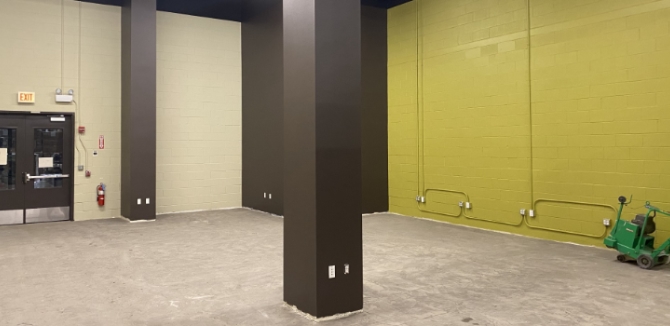
Benefits of hiring painting contractors during the spring
It’s always a good idea to bring in a professional contractor for your springtime painting projects. In fact, you might even save money by doing so, as your paint will last longer, not to mention look better. Quality outcomes are only possible when you hire the right contractor doing the work under the right conditions, including the following:
- Low humidity levels
The humidity begins to go down in the spring, which is perfect for painting, because too much moisture on surfaces can be detrimental to a paint job. With humidity levels low during the spring, you don’t run the risk of getting moisture trapped between the surface and the paint, which means the paint will adhere and last a long time. Furthermore, low humidity also helps the paint to dry faster, but not too fast. - Not too hot, not too cold
While the spring weather can bounce from one extreme to another, such as warm and sunny days to wet and cold days, rarely is it going to be too hot or too cold to paint. With a close eye on the forecast, a good contractor will choose the perfect spring days to tackle your most demanding painting project. - Less foliage
For exterior projects, painters have less foliage to contend with in the spring, which means less labor and a reduction in the amount of time it takes them to prep the job site for cleaning, priming and painting. - Price
The long and slow winter months have painting contractors eager to work in the spring when more preferable conditions arrive. And while business is picking up for them, most will charge a fee lower than their summer rates. - Repair winter damage
You want your commercial property to look the best it can, so if you’ve experienced severe ice storms, you probably have some damage to your exteriors that need to be addressed. The warmer spring temperatures and lower humidity make it a perfect time to jump on those repairs.
Even though spring might seem like a less-than-perfect time to start a painting project, there are advantages that can’t be ignored. Contact Painters Inc. and we’ll walk you through our springtime painting process and talk about how we will customize our approach to your project.
Commercial building interior painting in the spring
If you’re looking to get that “spring clean” look in your commercial interiors, the spring season is the perfect time to bring in new colors and bring more vibrance into the space. After a winter hunkered down inside, employees are ready for a fresh aesthetic and sometimes it only takes a few changes to achieve that.
Productivity is an important component to taking on a commercial interior painting project, which is why it is smart to plan your spring painting during off hours and to use low-to-no VOC paints, as the odor of these types of paint won’t linger and negatively impact people working indoors. Fortunately, if odor is present, spring weather permits opening windows to air out the property without impacting dry times of the paint or making anyone uncomfortably hot or cold.
As always, heat and humidity are important factors to consider before painting. The warmer spring weather means the climate controls aren’t as relied upon as they are in the winter and summer. Heating and cooling systems take a lot of moisture out of the air, which can negatively impact the dry times of paint and their ability to adhere to surfaces.
Another perk to addressing your interior needs in the spring is that you beat the rush that painting contractors experience for exterior summer work. This makes late March through May the perfect time to get your interiors completed before the contractors have limited availability.
Commercial building exterior painting in the spring
Winter in the Chicago area is no joke. The harsh weather is tough on commercial exteriors, especially the paint. You get more mileage out of your exterior paint when you hire a trusted contractor using high-quality exterior paint, but even then, after years of punishment, you’ll begin to see flaking and peeling. This not only looks bad, but it also can lead to structural damage. Springtime is the perfect season for addressing these damages.
One of the top reasons spring is a great time to address commercial exterior painting is due to the temperature. Paint doesn’t adhere properly when surfaces are too cold or too hot, but during the spring, particularly April and May, when average highs are in the 50s, that’s that perfect temperature for paint to cure. It won’t dry too fast or too slow, which is what professional contractors look for, because the paint lasts longer and the client gets more for their money.
Obviously, spring rains can put a damper on paint jobs, as too much moisture in the air or on surfaces is not an ideal situation for applying paint. This is why at Painters Inc., we pay close attention to the forecasts and schedule our exterior projects accordingly.
What is the best time for interior painting in the Chicago area?
While the majority of interior painting projects take place in climate controlled areas where paint will dry properly during any season, the main concern with planning these jobs involves humidity. Some interiors will be more humid than others, which means drying times must be adjusted between coats, and that takes careful monitoring on the part of the painters.
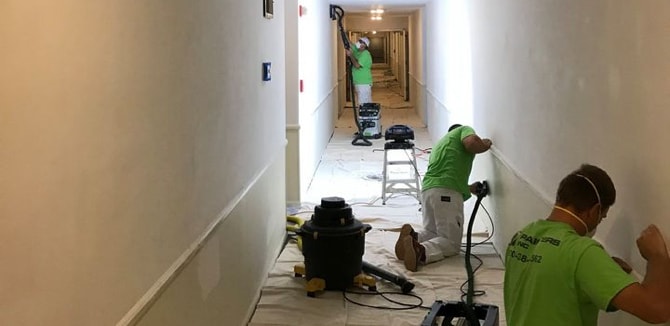
The ideal humidity level for interior paint projects in Chicago is between 40 and 70 percent for most types of painting. When the level dips below 40 or rises above 70, the paint doesn’t dry correctly, leading to flaws.
Many contractors say the winter is the best season to paint interiors, and this makes sense in Chicago as painting exteriors in freezing cold is basically impossible.
However, heating systems can pull a lot of moisture out of the interior air, causing a lack of humidity, which can negatively impact how paint dries. Quality contractors will carefully monitor humidity levels while undertaking winter interior painting projects.
Similarly, cooling systems also remove moisture from the air, which means interior painting projects during the summer months require the same careful consideration of the humidity. Given the number of contractors that focus on exterior jobs during the summer, it’s not generally seen as a popular season for interior painting, but inclimate weather will make time for interior projects.
At Painters Inc., we’re customer-centric, which means we plan our projects around our customers’ needs. And while we have to work around Mother Nature’s “schedule,” we will tackle an interior painting project during any season.
What is the best time for exterior painting in the Chicago area?
Simply put, the best time for an exterior painting project in Chicago is when the weather allows. Paint must not be applied when there is too much or too little humidity, or when surfaces and ambient air are too hot or too cold. Rain is also a no-go when it comes to exterior painting.
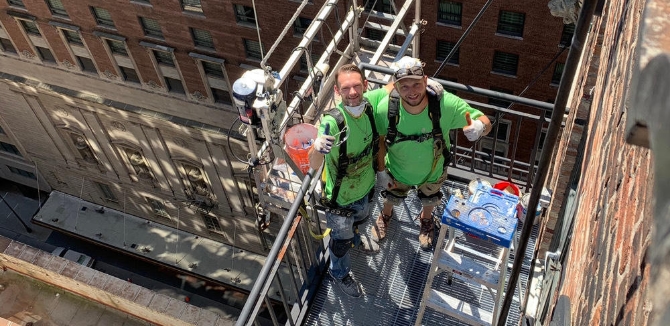
Summer is often the busiest season for exterior painting work. One of the best times to tackle these jobs is early summer, because the blistering heat has yet to set in. Remember, when it gets too hot outside, paint dries too fast, which means it will not last and will need to be repainted really soon. More specifically, the average high in Chicago in June is 77 degrees and average low is 63, which is great for applying paint.
Quality painting contractors will fill their schedules with exterior work in June.
September is another month where the temperature is ideal for painting. The summer heat has abated and the precipitation amount is lower in September than all the spring and summer months, which means exterior projects are far less impacted (delayed) by rain.
Keep in mind that some surfaces can be covered with special paint that can be applied in temperatures as low as 35 degrees or even lower (some solvent-based paints). While it’s more difficult to apply when cold weather thickens paint, when a job has to be done, there are options outside of the ideal months for taking on an exterior painting project. If your project calls for an oil-based paint, it can be applied at a low of 40 degrees, as its ingredients allow for colder weather drying/curing abilities.
Professional painters know when an exterior project is possible and when it’s a bad idea and they will schedule the work accordingly. At Painters Inc., we want all of our work to last as long as possible, which is why we only take on exterior work when the conditions are right.
Why spring is the best time to get your HOA or condo professionally painted
Coming out of a long and hard winter, the refreshing spring weather energizes property managers at condos and HOAs. They begin planning projects to enhance the property. From installing new siding and windows to landscaping – all types of improvements are considered and this includes paint. HOA's exterior and interior painting projects are popular during the spring, as the weather (when it’s not raining) is perfect for applying paint.
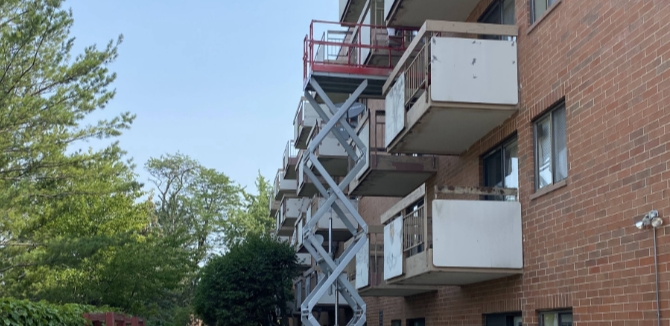
Painters often see areas that property managers cannot see, so it’s not uncommon for painters to spot surfaces and structures that need repair. It’s a side benefit that can save big money, because small fixes going unnoticed turn into expensive projects later. Spring is also an easier season to paint exteriors, as the trees and bushes aren’t in full bloom, making it easier to access areas that might be more complex in the summer.
Hire a professional painter for your building repainting this season
No matter what season you have your interior exterior painting project scheduled, it’s important to bring in trusted professionals to do the job for you. With more than 20 years of serving the Chicago area with high-quality interior and exterior painting services, we’ve built a reputation as a contractor that delivers premium results at a competitive price.
Working closely with property managers, owners and project leaders, we clearly discuss the fine details of every part of the project so nothing is missed. This ensures that the project is completed on time and in a way that best suits the needs of the customer. For example, we work around your hours and bring a high degree of respect for your property and the people working or living in it. The result of our way of doing business is reflected in our comments from customers.
Frequently asked questions about the best time to repaint your building
You don’t want a painting project to disrupt your workflow – you want your property to look great and have that important layer of protection. Some projects are better suited to certain weather conditions, so it only makes sense to plan these in advance. The following are some of the most frequent questions Painters Inc. gets about planning a painting project:
When is the right time to start planning a painting project?
If you know when you want to get started on your project, contacting a painting contractor as far in advance as possible is recommended, especially if your project is during the summer months.
Is it better to paint in summer or winter?
That depends on the type of work. Exterior jobs are best suited for the summer, whereas interior work is perfect for winter.
What is the best temperature for the paint to dry?
The preferred range is between 50 and 90 degrees, though some paints are specially formulated to be applied at much lower temperatures.
What temperature is too hot for outdoor painting?
Anything over 90 degrees is too hot, because at high temperatures, the paint dries too fast and will not adhere well to surfaces.
What happens if you paint in hot weather?
When paint is applied at surfaces nearing 100 degrees or over, the paint will crack, blister and/or peel.
Can you paint outside in winter?
Chicago temperature averages in the winter are often too cold for painting. In unseasonably warm conditions, exterior painting is possible.
What happens if you paint in weather that is too cold?
Paint will not dry fast enough in cold weather, which can cause color differences, cracking, blushing and other unsightly appearances. Oil paints become too viscous and will not apply evenly in the cold.
What is the most weather-resistant paint brand?
At Painters Inc., we rely on high-performance paints from Sherwin-Williams and Benjamin Moore. They produce hardy paints that withstand the elements and look amazing on your exterior (and interior) surfaces.
What are the signs that it’s time to repaint your building?
When paint has faded, chipped, cracked, bubbled or sagged, it’s time to call in your trusted painting contractor and schedule a consultation. Stains, mold and mildew are also signs that you’re in need of new paint.
If you have more questions, contact us at Painters Inc. We’re Chicago’s go-to painting contractor for interior and exterior work and we can help you with our projects throughout the year.









